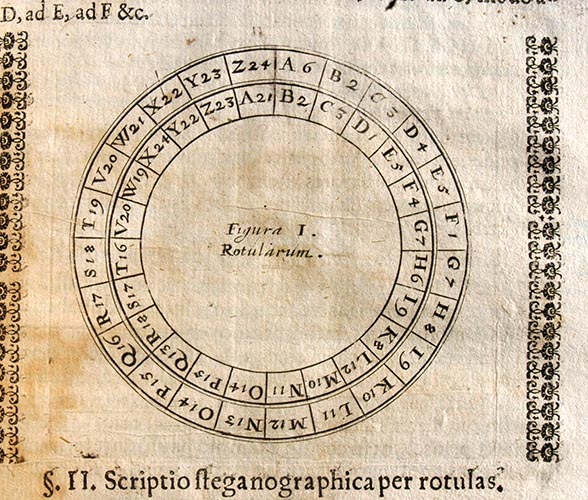|
Collections
in Cryptology Key mechanisms in computation... |
|
|
Research Notes: All material is Copyright (C) 2011 by Nicholas Gessler or by the owners of the images. This silver disk turned up in a small antique shop in Southern France and was subsequently purchased on eBay in 2006. |
|
|
Nicolas Bion's design corresponds exactly to the illustrations Schotti (below). |
There is a wide range of workmanship in Nicolas Bion's instruments as evidenced by the |
|
 "Figure 1:" A disk identical to Nicolas Bion's cipher disk in both numbers and letters. P. Gasparis Schotti, SCHOLA STEGANOGRAPHICA, 1680 edition (Gessler collection), figure 1, page 95. Apparently, the same plate was used for both editions as evidenced by the flaws at 11 o'clock. |
|
Left: The fronticepiece of Schotti's SCHOLA STEGANOGRAPHICA. Right: "Figure 2:" A disk similar to Nicolas Bion's but with a different association between numbers and letters. |
|
Outer disk letter sequence in numerical order: FBCDE AGHIK LMNOP QRSTV WXYZ Inner disk letter sequence in numerical order: DBCFE HGKIM NLQOP TSRWV AYZX
It seems likely that the progression served as a keying method: In a similar manner we could do the inverse, but it would not produce as irregular a key: Is this too complicated a procedure? Alberti suggested using a short key in the 1400s. The Rossignols were practised in cryptanalysis. By comparison, this procedure is relatively simple. |
|
 Time-Line of personages and publications. |
|
|
|
|
|
Works signed "Nicolas Bion" were not all done by the same hand. These two pieces are among the most masterfully executed.
Note the nearly identical lettering, "leafy flourishes" and swirling motives between the silver cipher (left) disk and the silver sundial (right). |
|
|
|